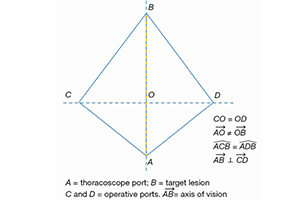Geometric and ergonomic characteristics of the uniportal video-assisted thoracoscopic surgery (VATS) approach
Abstract
During the last three decades, video-assisted thoracoscopic surgery (VATS) has been revolutionizing the surgical treatment of several thoracic pathologies. Compared to open thoracotomy, VATS has demonstrated not only a significant reduction in pain, recovery time and complications but also a significant improvement in the post-operative quality of life for patients. The uniportal VATS technique was initially described in the early 2000s. This technique involves the simultaneous introduction of instruments parallel to a thoracoscope through one small incision, the breadth of a surgeon's finger, without further dissection of the intercostal space. Some papers have already demonstrated the advantage of uniportal VATS in comparison to the traditional three-port techniques in reducing postoperative pain, length of hospital stay and time of return to activities of daily living. Standard three-port VATS has a geometric configuration of a trapezoid that interferes with the optical source by creating a new optical plane which generates a torsion angle not favorable with standard two-dimensional monitors. By contrast, the uniportal VATS approach along a sagittal plane from a caudo-cranial perspective enables a projective plane that preserves the depth of intraoperative visualization. The instruments, as parallel lines from this plane, enable the surgeon to bring the operative fulcrum inside the chest. In addition, the uniportal VATS approach can significantly improve the surgeons’ body posture during surgery since the surgeons can stand straight facing the monitor with minimal neck movement. Thus, the surgeons benefit from ergonomic advantages compared to the standard three-port approach.
Cover






